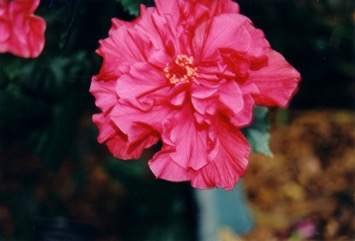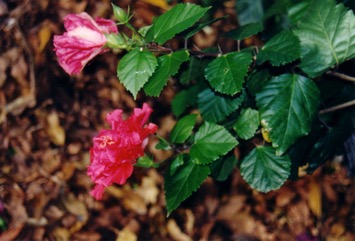Hibiscus, Rose of China

A tropical and subtropical plant. A common ornamental throughout the tropics. It originally came from China. It thrives on any type of soil. Different types are adapted to sunny or shady places. They grow where average temperatures are between 15-30°C. They are very sensitive to frost. They grow from sea level to 1000 m altitude. They probably require a minimum rainfall of 700 mm per year. It grows in Nepal to 1400 m altitude. It grows in open, moist places. It suits hardiness zones 9-11. In Sichuan and Yunnan.
Also known as:
Amapola, Aute samoa, Bup, Bunga raya, Bunga sepatu, Bussouge, Cha-baa, Chaba, Chembarathi, Chinese rose, Clavelon, Dam but, Dasavala, Dasindacha phula, Fasut jasum, Fu sang, Ghanti phul, Gugamela, Gumamela bulaklak, Japa, Jasavanda, Jasum, Jasut, Jasuva, Java pushpamu dasana, Java, Joba, Karibunamidi, Khaung-yan, Khaung-yan-ywet-hla, Kembang sepatu, Kembang sepatu mawar cina, Linyolo, Losi, Mamela, Mandaro, Mar pacifico, Mawkmnae, Pan-swe-le, Phurahong, Pushpam, Rooj, Rosa, Rudra, Saimaa, Sapattu mal, Semparuthi, Shoe flower, Te roti, Thelele, Vadamal, Watha wal, Woro wari, Zhu jin
Synonyms
- Hibiscus arnottii Griff. ex Mast.
- Hibiscus boryanus DC.
- Hibiscus cooperi auct.
- Hibiscus festalis Salisb.
- Hibiscus liliiflorus Griff. ex Mast.
- Hibiscus rosiflorus Stokes
- Hibiscus storkii Seem.
Edible Portion
- Leaves, Flowers, Vegetable
Where does Hibiscus grow?
Found in: Africa, Antigua and Barbuda, Asia, Australia, Bangladesh, Bermuda, British Indian Ocean Terr., BIOT, Burkina Faso, Central Africa, Central America, China, Congo, Costa Rica, Cuba, Dominican Republic, East Africa, East Timor, Fiji, France, FSM, Ghana, Greece, Guiana, Guianas, Guyana, Haiti, Hawaii, Himalayas, India, Indochina, Indonesia, Italy, Kiribati, Laos, Malawi, Malaysia, Maldives, Mariana Islands, Marquesas, Marshall Islands, Mediterranean, Micronesia, Mozambique, Myanmar, Nauru, Nepal, New Caledonia, Pacific, Pakistan, Palau, Papua New Guinea, PNG, Philippines, Pohnpei, Portugal, Rotuma, Samoa, Sao Tome and Principe, SE Asia, Sierra Leone, Slovenia, South Africa, Southern Africa, South America, Spain, Sri Lanka, St Helena, St. Kitts and Nevis, St Lucia, Suriname, Taiwan, Thailand, Timor-Leste, Tonga, Tuvalu, United States, Vanuatu, Vietnam, West Africa, West Indies, Zambia, Zimbabwe
Notes: It is used in medicine in Indonesia. There are about 220 Hibiscus species and many cultivated varieties of Hibiscus rosa-sinensis.
Status: In Papua New Guinea it is mostly grown as an ornamental but is eaten in some areas.
Growing Hibiscus, Rose of China
Cultivation: It is mostly grown from cuttings or grafting.
Edible Uses: The leaves are eaten cooked. In some places they are pounded before cooking. The flowers are eaten raw or pickled. They are also added to drinks. They are used to colour foods including preserved fruit, sliced pineapple, agar-agar jellies, and cooked vegetables. The fresh flower ovary is eaten.
Nutrition Info
per 100g edible portion| Edible Part | Energy (kcal) | Protein (g) | Iron (mg) | Vitamin A (ug) | Vitamin c (mg) | Zinc (mg) | % Water |
|---|---|---|---|---|---|---|---|
| Leaves | 77 | 2.3 | - | - | - | - | 76 |
| Leaves | 279 | 25.9 | 19.6 | - | - | 8.9 | 6.4 |
Hibiscus, Rose of China Photos


References
Abbiw, D.K., 1990, Useful Plants of Ghana. West African uses of wild and cultivated plants. Intermediate Technology Publications and the Royal Botanic Gardens, Kew. p 42
Ambasta, S.P. (Ed.), 2000, The Useful Plants of India. CSIR India. p 267
Blamey, M and Grey-Wilson, C., 2005, Wild flowers of the Mediterranean. A & C Black London. p 135
Bodkin, F., 1991, Encyclopedia Botanica. Cornstalk publishing, p 558
Brickell, C. (Ed.), 1999, The Royal Horticultural Society A-Z Encyclopedia of Garden Plants. Convent Garden Books. p 522
Brown, D., 2002, The Royal Horticultural Society encyclopedia of Herbs and their uses. DK Books. p 235
Burkill, H. M., 1985, The useful plants of west tropical Africa, Vol. 4. Kew.
Burkill, I.H., 1966, A Dictionary of the Economic Products of the Malay Peninsula. Ministry of Agriculture and Cooperatives, Kuala Lumpur, Malaysia. Vol 1 (A-H) p 1187
Cundall, P., (ed.), 2004, Gardening Australia: flora: the gardener's bible. ABC Books. p 702
Dharani, N., 2002, Field Guide to common Trees & Shrubs of East Africa. Struik. p 239
Engel, D.H., & Phummai, S., 2000, A Field Guide to Tropical Plants of Asia. Timber Press. p 168
Etherington, K., & Imwold, D., (Eds), 2001, Botanica's Trees & Shrubs. The illustrated A-Z of over 8500 trees and shrubs. Random House, Australia. p 379
Facciola, S., 1998, Cornucopia 2: a Source Book of Edible Plants. Kampong Publications, p 148
FAO, 1988, Traditional Food Plants, FAO Food and Nutrition Paper 42. FAO Rome p 325
Flora of Pakistan. www.eFloras.org
Flowerdew, B., 2000, Complete Fruit Book. Kyle Cathie Ltd., London. p 112
Fowler, D. G., 2007, Zambian Plants: Their Vernacular Names and Uses. Kew. p 82
Fox, F. W. & Young, M. E. N., 1982, Food from the Veld. Delta Books. p 262
Franklin, J., Keppel, G., & Whistler, W., 2008, The vegetation and flora of Lakeba, Nayau and Aiwa Islands, Central Lau Group, Fiji. Micronesica 40(1/2): 169–225, 2008
French, B.R., 1986, Food Plants of Papua New Guinea, A Compendium. Asia Pacific Science Foundation p 87
Grubben, G. J. H. and Denton, O. A. (eds), 2004, Plant Resources of Tropical Africa 2. Vegetables. PROTA, Wageningen, Netherlands. p 562
Hedrick, U.P., 1919, (Ed.), Sturtevant's edible plants of the world. p 345
Hibbert, M., 2002, The Aussie Plant Finder 2002, Florilegium. p 139
Jardin, C., 1970, List of Foods Used In Africa, FAO Nutrition Information Document Series No 2.p 81
Kuhnlein, H. V., et al, 2009, Indigenous Peoples' food systems. FAO Rome p 120
Lazarides, M. & Hince, B., 1993, Handbook of Economic Plants of Australia, CSIRO. p 132
Liu, Yi-tao, & Long, Chun-Lin, 2002, Studies on Edible Flowers Consumed by Ethnic Groups in Yunnan. Acta Botanica Yunnanica. 24(1):41-56
Lord, E.E., & Willis, J.H., 1999, Shrubs and Trees for Australian gardens. Lothian. p 236
Lugod, G.C. and de Padua L.S., 1979, Wild Food Plants in the Philippines. Vol. 1. Univ. of Philippines Los Banos. p 49
Lyle, S., 2006, Discovering fruit and nuts. Land Links. p 240
Malaisse, F., 1997, Se nourrir en floret claire africaine. Approche ecologique et nutritionnelle. CTA., p 63
Manandhar, N.P., 2002, Plants and People of Nepal. Timber Press. Portland, Oregon. p 261
Martin, F.W. & Ruberte, R.M., 1979, Edible Leaves of the Tropics. Antillian College Press, Mayaguez, Puerto Rico. p 49, 203
McMakin, P.D., 2000, Flowering Plants of Thailand. A Field Guide. White Lotus. p 28
Okigbo, B.N., Vegetables in Tropical Africa, in Opena, R.T. & Kyomo, M.L., 1990, Vegetable Research and development in SADCC countries. Asian Vegetable Research and development Centre. Taiwan. p 44
Peekel, P.G., 1984, (Translation E.E.Henty), Flora of the Bismarck Archipelago for Naturalists, Division of Botany, Lae, PNG. p 363, 360
Pham-Hoang Ho, 1999, An Illustrated Flora of Vietnam. Nha Xuat Ban Tre. p 523
Plants for a Future database, The Field, Penpol, Lostwithiel, Cornwall, PL22 0NG, UK. http://www.scs.leeds.ac.uk/pfaf/
Plants of Haiti Smithsonian Institute http://botany.si.edu/antilles/West Indies
Ruiters-Welcome, A. K., 2019, Food plants of southern Africa. Ph.D. thesis. Univ. of Johannesburg p 76
Solomon, C., 2001, Encyclopedia of Asian Food. New Holland. p 180
Sp. pl. 2:694. 1753
Staples, G.W. and Herbst, D.R., 2005, A tropical Garden Flora. Bishop Museum Press, Honolulu, Hawaii. p 389 (Drawing)
Sukarya, D. G., (Ed.) 2013, 3,500 Plant Species of the Botanic Gardens of Indonesia. LIPI p 643
Swaminathan, M.S., and Kochnar, S.L., 2007, An Atlas of Major Flowering Trees in India. Macmillan. p 39
Tanaka,
Terra, G.J.A., 1973, Tropical Vegetables. Communication 54e Royal Tropical Institute, Amsterdam, p 50
Thaman, R. R., 1987, Plants of Kiribati: A listing and analysis of vernacular names. Atoll Research Bulletin No. 296
Topp, J. M. W., 1988, An Annotated Check List of the Flora of Diego Garcia, British Ocean Territory. Atoll Research Bulletin No. 313
Valder, P., 1999, The Garden Plants of China. Florilegium. p 290
Wehmeyer, A. S, 1986, Edible Wild Plants of Southern Africa. Data on the Nutrient Contents of over 300 species
Wijayakusuma, H.M.H., et al, 1996, Tanaman Berkhasiat Obat Di Indonesia. Pustaka Kartini. p 83
Williamson, J., 2005, Useful Plants of Malawi. 3rd. Edition. Mdadzi Book Trust. p 132
World Checklist of Useful Plant Species 2020. Royal Botanic Gardens, Kew
Young, J., (Ed.), 2001, Botanica's Pocket Trees and Shrubs. Random House. p 442
Yuncker, T.G., 1959, Plants of Tonga, Bernice P. Bishop Museum, Hawaii, Bulletin 220. p 183
Zuchowski W., 2007, Tropical Plants of Costa Rica. A Zona Tropical Publication, Comstock Publishing. p 140